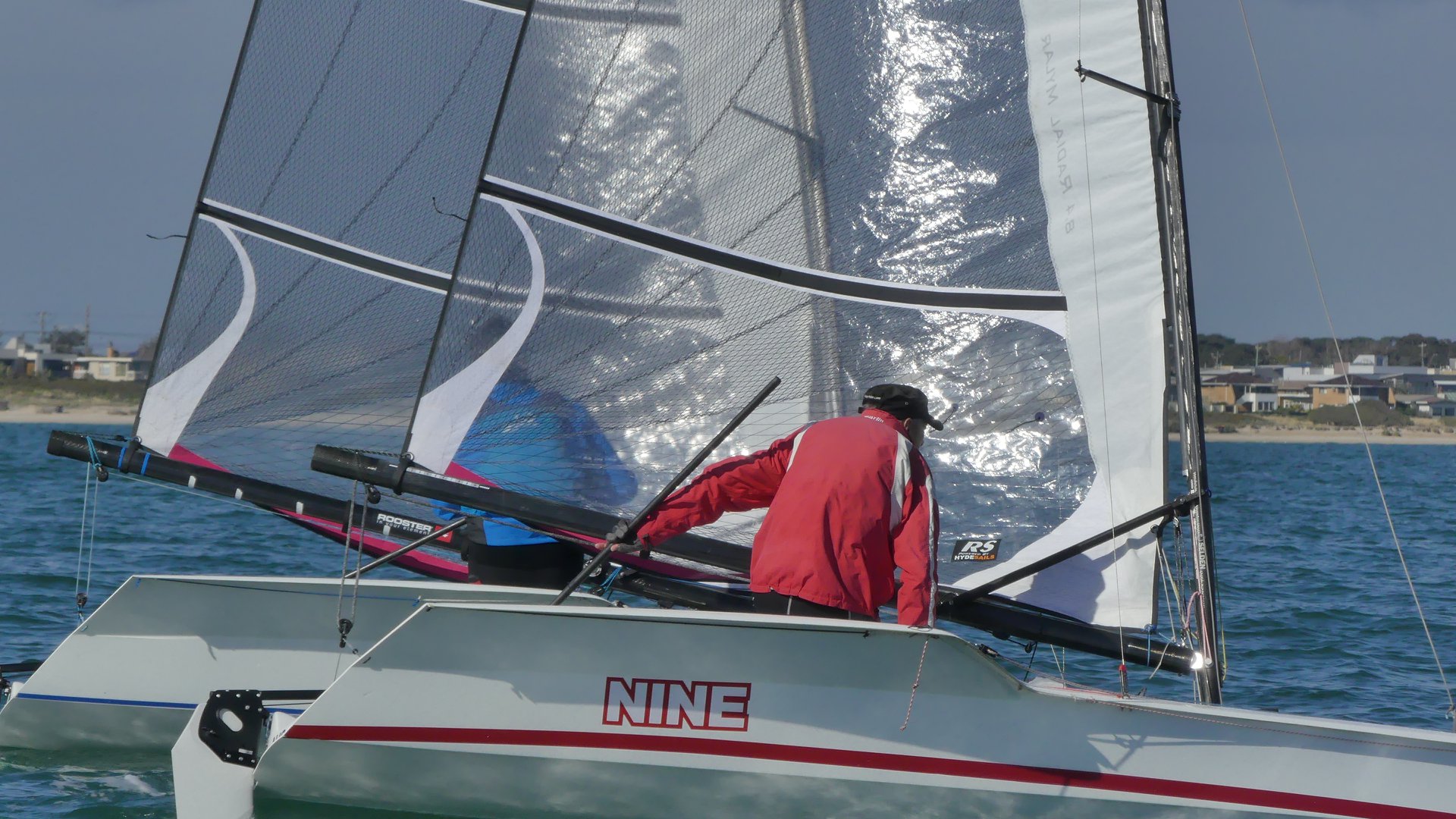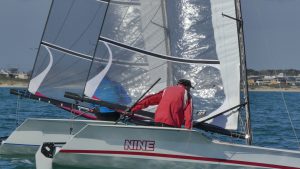

A well-sailed boat in light air can go twice as fast as its competitors for a large part of the race. The largest race-winning leads are regularly recorded in the lightest of conditions.
Polish the bottom and remove any un-required gear from the boat.
Drop purchases from the various systems especially the main and jib sheets to remove friction. Replace sheets with small diameter ropes for the same reason.
Telltales
Mast Prebend
It is not unusual for the main leech to hook and although this looks bad, it can be beneficial to have the mainsail shape a bit rounder in the after sections. This induces a slight weather helm and helps with pointing capability.
In drifting conditions, the upper batten should be set parallel to the centerline. As soon as the wind picks up, switch the trim back to having the upper batten parallel to the boom.
The Traveller
In really light air, the traveller is pulled to weather so that the slightest puff allows the boom to lift easily.
As the breeze picks up, drop the traveller down so the boom stays at or below the centerline while you trim so the upper batten is parallel to the boom.
The Slot in light-air sail trim.
In light air avoid having the main backwind at the luff. When the main is angled off the centerline, the slot is in danger of being closed off. To avoid this, flatten the mainsail to suit.
The exit of the jib must be open. Move the jib lead aft and ease the sheet slightly to open the leech and flatten the lower sections.
In extremely light air have a crew member hold the jib clew up to keep the leech open.
Jib Halyard Tension
The jib should become increasingly full in its forward sections and in light air should be set up with a lot more luff sag.
A full entry helps widen the groove so the boat is less critical to steer. Too much halyard tension creates a knuckle at the front of the jib and interferes with the airflow.
Downwind Sail Trim
Ease the outhaul and straighten the mast. The crew should hold the clew outboard and up so that the leech is open and the jib is not too full.
The main can have a rounded leech and maximize the sag in the luff of the jib to make the entry more powerful. Ease the halyards on the jib and main and let the Cunningham go.
In some classes, often in very light air, it may make sense to not carry the spinnaker across or even downwind.
When reaching, the spinnaker should have flow across it. If it’s drooping it will actually slow the boat down. Instead, a narrow, flatter jib can be a better alternative.
When sailing dead downwind, the flow is not across the spinnaker so the more area that can be projected, the better.
With a symmetrical spinnaker, adjust the pole height so that the two ends are even at all times. Always keep the spinnaker sheet well eased, since an over-trimmed spinnaker will choke the slot.
When sailing broader angles, pull the spinnaker to weather as far as possible keeping the pole perpendicular to the wind.
Light-Air Boat Handling
Because the boat moves slowly in light air, crew movement, particularly during maneuvers must be made slowly to retain the attached flow across the sails.
The boat heel becomes critical in steering the boat upwind in light air conditions. When you need to head up, heel the boat to leeward, and when you want to bear off, flatten it out.
When a puff hits you, allow the boat to heel slightly so that the weather helm will increase. This lets the boat slide up closer to the wind without using any rudder. When you get as high as you want to be, hike the boat flat gently to accelerate.
If only one person is needed to make the changes in the heel, get the skipper to do so. He can feel the puffs and the load on the helm much more quickly than the crew.
Make sure the crew stays as low as possible to reduce windage and keep the slot clear. Keep weight forward and concentrated in the middle of the boat, but slightly heeled to get the right weather helm.
Steering
Steering the boat downwind by means of heel is important to eliminate drag caused by rudder movement. If there is enough wind to use the rudder to steer, use it sparingly. Any time the rudder is turned, especially in light air, it acts like a brake.
Many people think that because they are sailing in flat water, they can point closer to the wind.
Until the wind speed is higher, the boat will not move fast enough for the blades to develop lift. Although it may seem that your angle to the wind is higher, if the blades are stalled, the boat will simply slip sideways.
Instead, foot the boat off to keep it moving through the water and take advantage of the increased apparent wind from the added speed.
It may seem that you are giving up distance to weather on the boats that are pointing higher but the speed that you gain through the water will put you ahead.
How far to bear off depends on the individual boat, but a basic rule of thumb is to bear off from your normal close-hauled course more than you think you should, and then add another five degrees.
Tactical Considerations
Light-air tactics demand more conservatism and greater anticipation.
It is imperative that the boat is moving at top speed at the gun and it is possible to sail through the lee of a slow-moving windward boat.
The approach to the start must be made in such a way that you maintain maximum speed.
The main priority for a light-air start is top speed, sometimes at the expense of starting away from the favoured end of the line. Often it is better to start at the unfavored to avoid traffic and to get clear air.
Upwind, avoid tacking into a safe leeward position unless absolutely necessary, such as on the final layline to the weather mark. There is a danger of being rolled by the windward boat and you forfeit the option of tacking.
Being controlled by another boat severely limits your options.
Often you can gain distance when you dip a starboard tacker because of the extra speed you generate when bearing off. When on starboard tack, don’t be afraid to wave an approaching port tacker across if it looks like they might tack on your leebow to avoid you.
In light winds, avoid the middle of the course and the dirty air that boats to weather and ahead may provide. Look up the course, search for new wind, and predict which side of the course it will be on.
If a new wind comes with more velocity, always sail to it as soon as possible, even if this requires sailing a headed tack to get to it. Obviously, a massive shift would be an exception to this rule, if the shift were to last a substantial length of time.
Tacking Angles
Changes in tacking angles are not related to wind shifts unless the velocity changes are accompanied by a wind shift.
The team member reading the compass should be aware of the effect of the velocity on the tacking angles as well as the change in the compass readings.
If you sail into a lull, the boat will want to bear off in what will appear to be a header. Since the change in angle will make the leeward boat look better, it may be tempting to tack.
Sometimes the velocity drops so quickly that the sails may luff due to the apparent wind swinging forward. Wait for the boat to slow down to match the hull speed with the wind velocity.
Don’t let the luffing sails make you think that you have sailed into a massive header. Hang on for a few seconds to make sure that it’s a header and not just a drop in velocity.
An increase in velocity will show as a lift because the boat’s blades will gain efficiency as the speed picks up. On a multi-crewed boat, one crew concentrates on the compass to pick out major shifts, and another crew reminds him of the puffs and lulls.
BOOK FOR YOUR SAILING BUDDY (and one for yourself)
Keep Your Eyes Out Of The Boat
In light air and since boat speed is so low and tactics are accomplished slowly, every move must be anticipated. The crew’s eyes should be all over the course, looking for changes in wind velocity and direction.
Watch other boats for changes in angle which could also predict possible wind shifts.
Take advantage of other competitors’ dislike of racing in light air. Having an excellent attitude will lead you toward regatta-winning finishes.

